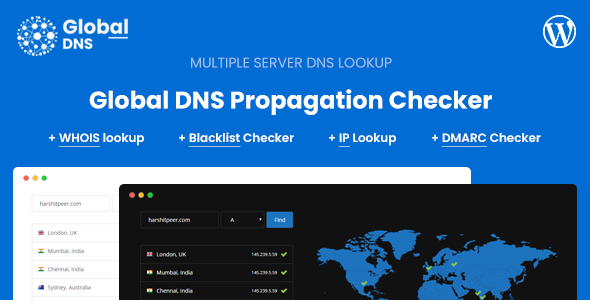Global DNS – DNS Propagation Checker – WHOIS Lookup – WP Wordpress Plugin - Rating, Reviews, Demo & Download

Plugin Description
Global DNS allows you to instantly check the DNS records across multiple servers. It provides an insight to end users on which server website is pointing to. It is also helpful to check the current DNS entries incase the DNS records are changed.
Features
Multiple DNS Record Types
You and your end users can check multiple types of DNS records like A, MX, NS, CNAME, TXT and much more. There are a total of 10 types of DNS records to check.
Multiple Servers
There is no limit on how many servers you can add, more the severs better the stats.
Dark Mode
Following current trend, Global DNS also has a Dark Mode. You can enable this from the Admin Dashboard in Global DNS Settings page. Based on which WP Editor you’re using, you also need to set the background colours accordingly.
Requirements
For WHOIS Lookup, you will need PHP fsockopen and enable TCP Port 43 for Outgoing traffic
You will need a WordPress website to install this WordPress Plugin. You will also need multiple shared hosting account to act as a server for this plugin.You can also opt for Free Servers at this URL here
From v1.1.0 you can directly use DNS Server IP to fetch the DNS Records, but for that you will need shell_exec function.
If there is any confusion in the requirements please contact us via email option in the profile here
Change Log
v2.9.1 - 2 October 2024
- Fixed Blacklist Server Delete
- Fixed Alignment Issue for DNS Type Dropdown
- Fixed Expected Value Button
- Minor Design Changes
v2.9.0 - 2 July 2024
- Added Email Headers Extractor
- Fixed WHOIS and DMARC Issues
- Updated instructions to include configuration for shortcodes
v2.8.0 - 16 April 2024
- Added Management for Blacklist Servers (Add/Update/Delete Servers)
- Fixed minor DMARC Issues
- Added domain/ip for Blacklist Check and DMARC in URL for ease of sharing
v2.7.0 - 21 January 2024
- Added DMARC Checker
- Fixed URL for Blacklist Checker
v2.6.0 - 10 October 2023
- Added Blacklist Checker
- Improved Minor UI Flaws
v2.5.0 - 3 July 2023
- Added IP Lookup Tool
- Optimized CSS Files
v2.4.0 - 5 April 2023
- Added User IP Shortcode
- Fixed Minor CSS Issues
- Optimized Shortcode View in Admin Panel
v2.3.0 - 5 January 2023
- Added Timeout for DNS and WHOIS Request
- Improved WHOIS Input Cleanup
v2.2.0 - 6 October 2022
- Added ability to sort servers
- Fixed placeholder for WHOIS Domain
v2.1.0 - 19 July 2022
- Added Meta Detail for Server (You can use it for adding Provider, Sponsor, etc)
- Fixed PHP 7.2 Error
- Fixed Dark Mode Enabler
v2.0.1 - 30 April 2022
- Fixed Minor Servers Update Bug
v2.0.0 - 30 April 2022
- Redesigned Admin UI
- Added WHOIS Lookup
- Added Custom CSS for Advance Users
- Fixed Minor UI Issues
v1.5.0 - 5 November 2021
- Added Background and Text colour for Expected Icon
- Fixed Minor Cosmetic Issues
v1.4.0 - 20 May 2021
- Added Expected Feature
- Fixed Minor Responsiveness Issue
v1.3.1 - 26 April 2021
- Added inhouse flags
v1.3.0 - 26 November 2020
- Added ability to change the "Find" button text
- Added ability to change input field placeholder
- Minor Bug Fixes
v1.2.1 - 4 August 2020
- Optimized WordPress Files
v1.2.0 - 10 July 2020
- Added ability to set default DNS Type
- Added ability to re-arrange server list
- Fixed PTR issues when using direct DNS Server IP
- Fixed minor code and design issues
v1.1.0 - 26 April 2020
- Added ability to add DNS Server IP for fetching records
- Added ability to import the servers from CSV file
- Added ability to export the servers to CSV file
- Added ability to delete all the current servers in a single click
- Fixed minor cross-site issue
v1.0.3 - 20 March 2020
- Fresh URLs are auto-generated on each search
- Minor enhancements and fixes
v1.0.2 - 9 March 2020
- Ability to configure the Shortcode
- Cleaned the API Part
- Alignment Fixes
v1.0.1 - 5 March 2020
- Added Tutorial Video in Dashboard
- Added ability for the end-user to see that search is going on
- Added ability for the system to understand the domain name when URL is provided by the end user
















